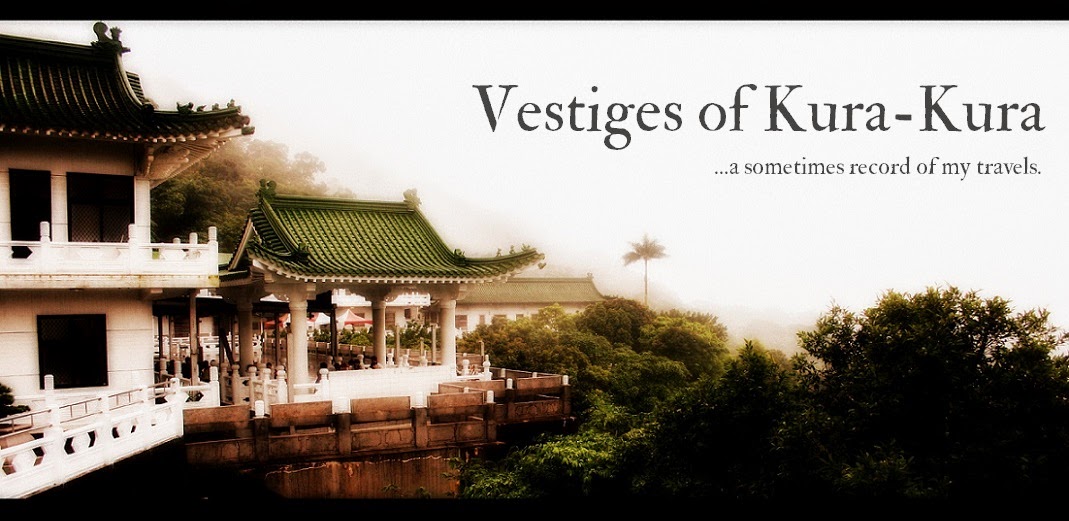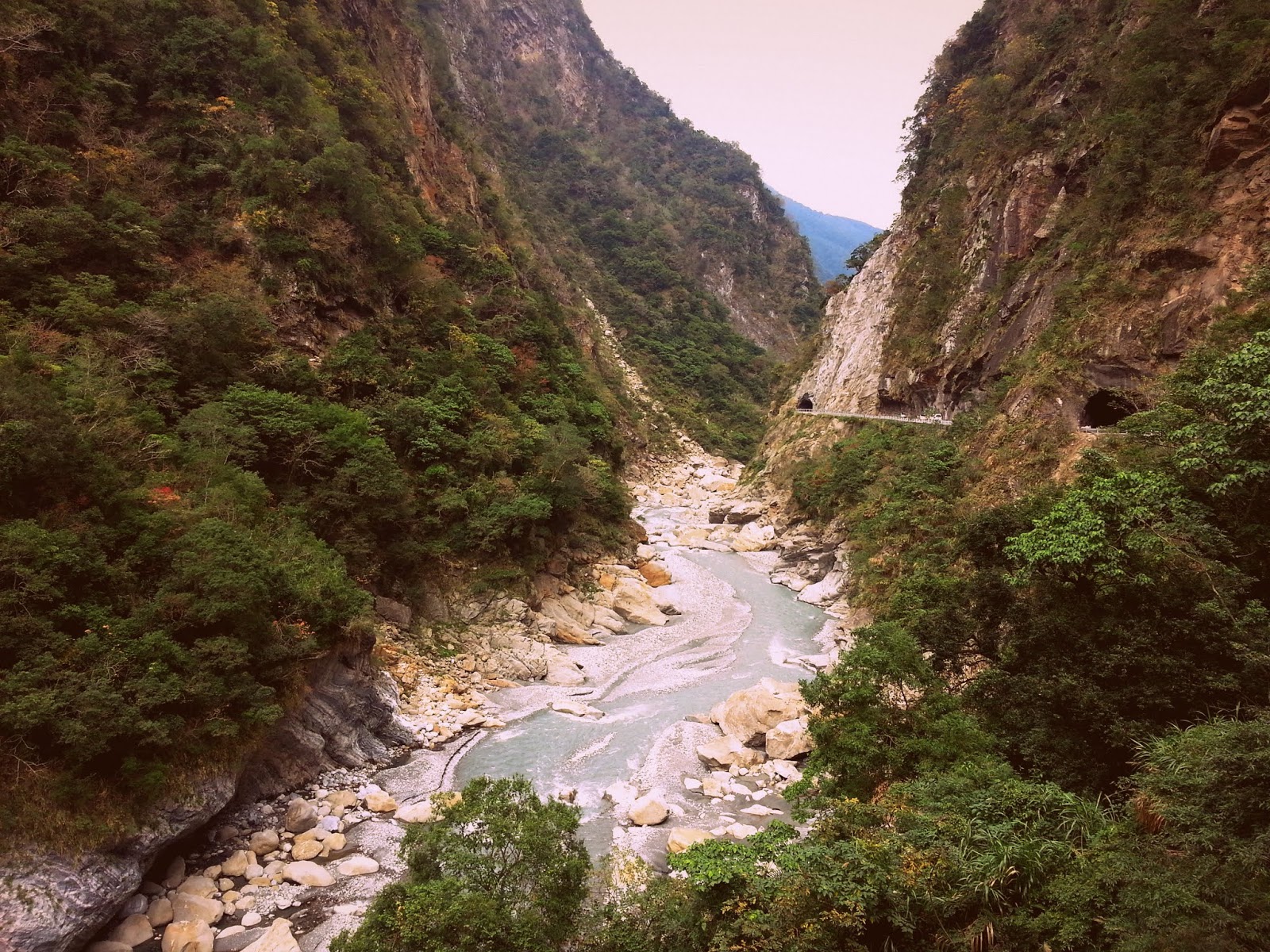Click here for Day One at Taroko National Park.
Day Two:
We started the day back at the entrance of the park, first stopping at the tourist center (national parks in Taiwan have wonderful tourist centers with friendly, informative staff, clean restrooms, and free water refill machines). First up for the day was Shakadang Trail. Unfortunely we soon realized that this is also the first trail of the day for the tour buses (why they all seem to travel together, I don't know... maybe so as not to punish the other visitors), so the start of the trail was packed with people taking selfies. It's a 4.5km trail cut into a mountain and following a river - a level, easy path leading to 3D Cabin... except that it was closed about a kilometer and a half in! Neither the park's website, maps, visitor center, or even the trailhead mentioned this!!! Unfortunately there were a few makeshift stands selling sausages and jewelry causing people to linger in the area, otherwise we would have crossed the barricade and seen how far we could go. (Signs noting fines and hotlines to call if you saw people crossing were what made us care that people would see us.)
 |
| cut into the mountain, Shakadang Trail |
 |
| the relatively easy but pleasant Shakadang Trail |
 |
| trail closed ahead, Shakadang Trail |
Continuing on, we drove our motor scooter back up the gorge's road passing many of the places we visited yesterday and headed to Lushui Trail, which is a short trail overlooking the the road as well as the Liwu River below. There are more tunnels, so again a flashlight is extremely useful. (This time actually I remembered my headlamp, as yesterday we had to use our phones for light.) Being so close to the road there is surprisingly nice landscape and we did mange to see one wild monkey hanging out in a tree staring at us. It's a level, 2km walk. There are also numerous signs warning of falling rocks, and if you don't believe the signs, there are more than enough fallen rocks on the trail and dented fence bars to given them merit.
 |
| Beware of Rockfalls, Lushui Trail |
 |
| Lushui Trail |
 |
| view of Liwu River from Lushui Trail |
Still having time left in the day because Shakadang Trail was closed, we headed further up the road to check out Lianhua Pond Trail. This wasn't on our itinerary but it turned out to be more than worthwhile, if not one of the more scary trails I've ever done. The trail to the village beyond (Meiyuan Zhucun agricultural road) was closed due to landslide damage(?), but the detour to the pond was still open. [I believe they are both open now.] The trail is high above the river and the sheer straight drop down is vertigo inducing. The first suspension bridge is insanely high and about two-thirds of the way across we realized that at one point it broke (or was about to break) and has since been haphazardly fixed with a mixture of wooden planks and plastic plumbing pipes. I usually don't mind heights but crossing that makeshift fix-up was mentally difficult. I've crossed a lot of suspension bridges in this country but this was the highest and the only one I've actually felt afraid on.
 |
| seriously damaged with scary sheer straight drops down, Lianhua Pond Trail |
 |
| the last third of it improvised, Jiumei Suspension Bridge |
 |
| and then we realized the bridge was broken, Jiumei Suspension Bridge |
After the deathly-high suspension bridge we crossed a number of landslide areas that tested our guts, and should be avoided by most people. The trail has been wiped out in two or three places (I'm forgetting now), but people still continue to cross. One false move or slip of the foot and we would have slide down to our deaths. I felt like the worst part was knowing that every tricky pass we did had to be retraced to get back to our motor scooter on the main road. All the tourists we saw at the beginning of the day were nowhere to be seen. We only saw two other Taiwanese couples hiking here. There was also an older man, who effortlessly crossed one of the landslide-destroyed bits (he had plastic toys poking out from his backpack and was likely a villager heading home along the closed path beyond).
To add to the tension, there were numerous rocks (ranging from small rocks to large boulders on the path that had clearly fallen from above. Neither of us had brought our scooter helmets this time, and though we joked about wearing them yesterday, today they were looking potentially useful. However, we could also see massive dents on the bars along the path's edge that implied helmets wouldn't do squat to save us if the right rock decided to fall. It was a thriller of a trail, but I admit that both my friend and I felt seriously uneasy.
After we crossed the second bridge and began the ascent up to the pond, it started to drizzle. We still had to return back across those landslide areas and if the trail became wet, we worried that they would become impassable. So we debated for awhile about whether to return or continue on, hoping the rain wouldn't worsen. Guessing that the pond would be underwhelming and that we had already seen what this ascent had to offer in terms of scenery, we eventually turned around and started heading back. Actually, crossing those scary parts was a lot easier the second time around, and I felt a bit foolish for being so scared the first time. Also, I insisted on going first this time, as I think watching my somewhat clumsy friend cross them had freaked me out more than if I had just done them without seeing him first.
 |
| dented and missing barricades due to falling rocks, Lianhua Pond Trail |
 |
| the much safer, second bridge, Jiumei Bridge |
We reached our motor scooter safely, and decided to head further up the road, which my friend had driven before years ago when crossing the island by motorcycle. It was still drizzling, but not enough to warrant us heading back just yet. As the road continues on, the elevation continues upward and the weather gets colder and colder. Soon we were in either a deep fog or the clouds, in this weather it was hard to tell one from the other. At this point I was hugging my friend tightly for both warmth and protection against the increasing hard, cold pellets of rain. We continued driving for maybe forty-five minutes, not reaching as high as he wanted to show me, but it was so foggy that there wasn't much of a view, not to mention that I couldn't see anything through my helmet's rain-and-fogged-out visor. Plus, I was shivering uncontrollably with cold.
Not long after we had turned around we heard a loud thump on the road behind us. I didn't feel safe enough to turn around, but I immediately knew it was a falling rock hitting the road. My friend caught a glimpse of it in the scooter's mirror, and rather skittishly said that that was not something he wanted to see. I didn't inquire further, and neither of us were interested in turning around to check it out. Freezing, wet, and uncomfortable, we were both very ready to leave.
As we descended back down the rain slowed until it finally stopped, and the temperature became bearable again. We passed all the trails we had done in the past two days, as well as all the parked tour buses in front of Eternal Spring Shine, right on time for whatever there is or isn't to see in the early evening / late afternoon. After we passed through the main entrance to the national park, we stopped at 7-Eleven to rest and warm up with some soup and hot chocolate. Since it wasn't raining anymore, my friend let me drive the hour back to the hostel (I don't have a license and this was only my second time riding a scooter in traffic... Taiwan traffic at that). I managed not to kill us, though I had trouble keeping the scooter balanced when stopping at a couple of the stoplights. I blame my friend's weight for throwing off me off, and not my mad scooter skills.
For more information visit Taroko National Park's very informative website.
*** Check their website for trail opening and closures as they often change. ***
Two days is more than enough time to explore Taroko Gorge's basic offerings, though there are a couple amazing trails that require permits in advance, but those are better saved for special trips out and not first-time visits. River tracing is also popular during certain seasons.


































